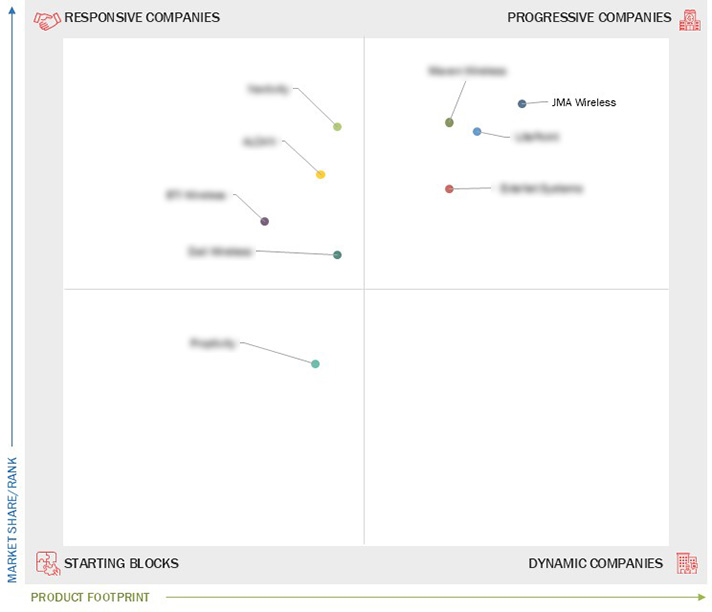Comparing 9 vendors in Indoor 5G Startups across 0 criteria.
Indoor 5G refers to deploying high-speed, low-latency 5G networks inside buildings and enclosed environments such as hotels, airports, offices, hospitals, shopping malls, and factories. With businesses and consumers demanding faster, more reliable, and secure connectivity, indoor 5G is becoming essential for smart buildings and next-generation digital services. It enables uninterrupted communication, enhanced automation, and advanced AI-powered operations, making it a game-changer across multiple industries.
Market Leadership Quadrant
1.1 Study Objectives
1.2 Market Definition
1.3 Study Scope
1.3.1 Markets Covered and Regional Scope
1.3.2 Inclusions and Exclusions
1.3.3 Years Considered
1.4 Currency Considered
1.5 Unit Considered
1.6 Limitations
1.7 Stakeholders
2.1 Introduction
2.2 Market Dynamics
2.2.1 Drivers
2.2.1.1 Demand For energy-efficient and sustainable buildings
2.2.1.2 Need for supporting mission-critical applications
2.2.1.3 Urbanization and smart city initiatives
2.2.1.4 Enhanced public safety through 5G technology
2.2.2 Restraints
2.2.2.1 Cost constraints
2.2.2.2 Integration challenges
2.2.3 Opportunities
2.2.3.1 Emerging markets and government subsidies
2.2.3.2 Advancements in technology
2.2.3.3 Deployment of 5G networks
2.2.4 Challenges
2.2.4.1 Regulatory compliance
2.2.4.2 Technological complexity
2.2.4.3 User experience expectations
2.3 Trends/Disruptions Impacting Customer Business
2.4 Value Chain Analysis
2.5 Ecosystem Analysis
2.6 Investment and Funding Scenario
2.7 Technology Analysis
2.7.1 Key Technologies
2.7.2 Complementary Technologies
2.7.3 Adjacent Technologies
2.8 Patent Analysis
2.9 Trade Analysis
2.10 Porter’s Five Forces Analysis
2.10.1 Threat of New Entrants
2.10.2 Threat of Substitutes
2.10.3 Bargaining Power of Suppliers
2.10.4 Bargaining Power of Buyers
2.10.5 Intensity of Competitive Rivalry
3.1 Introduction
3.2 Key Player Strategies/Right to Win
3.3 Revenue Analysis
3.4 Market Share Analysis
3.5 Company Valuation and Financial Metrics
3.6 Brand/Product Comparison
3.7 Company Evaluation Matrix: Startups/SMEs
3.7.1 Progressive Companies
3.7.2 Responsive Companies
3.7.3 Dynamic Companies
3.7.4 Starting Blocks
3.7.5 Competitive Benchmarking: Startups/SMEs
3.7.5.1 Detailed list of key startups/SMEs
3.7.5.2 Competitive benchmarking of key startups/SMEs
3.8 Competitive Scenario
3.8.1 Product Launches and Developments
3.8.2 Deals
4.1 ALCAN System
4.1.1 Business overview
4.1.2 Products/Solutions/Services offered
4.1.3 Recent developments
4.2 BTI Wireless
4.2.1 Business overview
4.2.2 Products/Solutions/Services offered
4.2.3 Recent developments
4.3 Dali Wireless
4.3.1 Business overview
4.3.2 Products/Solutions/Services offered
4.3.3 Recent developments
4.4 ExteNet Systems
4.4.1 Business overview
4.4.2 Products/Solutions/Services offered
4.4.3 Recent developments
4.5 JMA Wireless
4.5.1 Business overview
4.5.2 Products/Solutions/Services offered
4.5.3 Recent developments
4.6 LitePoint
4.6.1 Business overview
4.6.2 Products/Solutions/Services offered
4.6.3 Recent developments
4.7 Maven Wireless
4.7.1 Business overview
4.7.2 Products/Solutions/Services offered
4.7.3 Recent developments
4.8 Nextivity
4.8.1 Business overview
4.8.2 Products/Solutions/Services offered
4.8.3 Recent developments
4.9 Proptivity
4.9.1 Business overview
4.9.2 Products/Solutions/Services offered
4.9.3 Recent developments


 TechAfrica News
TechAfrica News
 Mar 2025
Mar 2025

